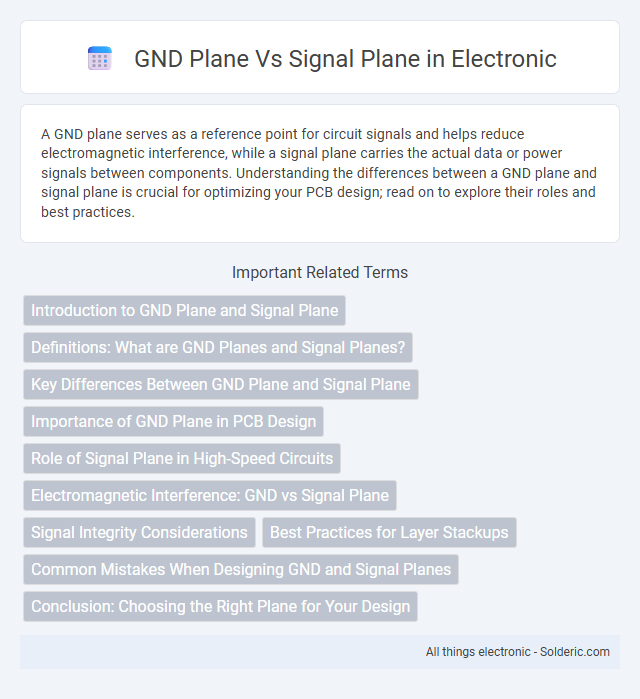A GND plane serves as a reference point for circuit signals and helps reduce electromagnetic interference, while a signal plane carries the actual data or power signals between components. Understanding the differences between a GND plane and signal plane is crucial for optimizing your PCB design; read on to explore their roles and best practices.
Comparison Table
| Aspect | GND Plane | Signal Plane |
|---|---|---|
| Definition | Continuous copper layer used as a reference ground. | Copper layer routed with signal traces for data transmission. |
| Primary Purpose | Provides a low impedance return path for signals and reduces noise. | Transmits electrical signals between components. |
| Noise Reduction | Minimizes electromagnetic interference (EMI) and crosstalk. | More susceptible to EMI; depends on routing and shielding. |
| Impedance Control | Helps maintain stable reference voltage and impedance. | Critical for signal integrity; controlled impedance traces. |
| Signal Return Path | Serves as the primary return path for signals. | Signal path itself; return currents flow in adjacent ground plane. |
| Layer Usage | Typically a solid, uninterrupted plane layer. | Discontinuous traces routed to connect components. |
| Effect on PCB Performance | Improves overall signal quality and reduces ground bounce. | Directly affects signal speed, integrity, and crosstalk. |
Introduction to GND Plane and Signal Plane
The GND plane, or ground plane, serves as a reference point for all electrical signals and provides a low-impedance path for return currents, minimizing electromagnetic interference (EMI) and maintaining signal integrity. The signal plane carries the actual data or power signals between components, and its performance relies heavily on the proximity and quality of the adjacent GND plane to reduce noise and crosstalk. Proper design and alignment of the GND and signal planes are crucial in high-speed PCB layouts to ensure optimal electrical performance and EMI control.
Definitions: What are GND Planes and Signal Planes?
GND planes, or ground planes, are continuous conductive layers in a PCB that serve as a common electrical reference point for circuits, minimizing noise and providing stable voltage levels. Signal planes, on the other hand, are layers dedicated to routing electrical signals between components, designed to optimize impedance and reduce crosstalk. Both GND and signal planes play crucial roles in PCB design by ensuring signal integrity and electromagnetic compatibility.
Key Differences Between GND Plane and Signal Plane
The GND plane serves as a reference plane providing a stable, low-impedance path for return currents and minimizing electromagnetic interference, while the signal plane carries high-frequency or sensitive signals requiring controlled impedance for signal integrity. GND planes are typically continuous copper areas that reduce noise and crosstalk, whereas signal planes consist of routed traces or conductive patterns tailored for specific signal paths. The primary difference lies in their electrical function: GND planes ensure grounding and noise reduction, while signal planes focus on accurate signal transmission and timing.
Importance of GND Plane in PCB Design
The GND plane in PCB design serves as a critical reference point for signal integrity, minimizing noise and electromagnetic interference by providing a low-impedance return path. Proper implementation of your GND plane ensures stable voltage levels and reduces signal distortion, enhancing overall circuit performance. Signal planes rely on the GND plane to maintain consistent impedance and improve high-frequency signal transmission.
Role of Signal Plane in High-Speed Circuits
The signal plane in high-speed circuits plays a crucial role in maintaining signal integrity by providing controlled impedance paths and minimizing electromagnetic interference. It is meticulously designed to reduce crosstalk and signal reflection, ensuring accurate data transmission at gigahertz frequencies. Proper separation from the ground plane and adherence to layout best practices optimize the performance of high-speed signals.
Electromagnetic Interference: GND vs Signal Plane
A GND plane provides a low-impedance return path that significantly reduces electromagnetic interference (EMI) by minimizing loop area and maintaining consistent reference potential. In contrast, a signal plane without an adjacent ground plane increases EMI susceptibility due to larger loop areas and discontinuous return currents. Proper layer stacking with a dedicated GND plane next to signal layers is essential for effective EMI control in high-speed PCB designs.
Signal Integrity Considerations
A GND plane provides a low-impedance return path essential for maintaining signal integrity by minimizing electromagnetic interference and crosstalk. Signal planes, when stacked adjacent to GND planes, reduce loop inductance and help preserve signal quality at high frequencies. Your PCB design benefits from careful layer stacking to balance signal return currents and prevent signal distortion or timing issues.
Best Practices for Layer Stackups
Optimal layer stackups balance GND planes and signal planes to minimize noise and crosstalk while ensuring signal integrity. Placing a continuous GND plane adjacent to signal layers creates controlled impedance and effective return paths, reducing electromagnetic interference. Your PCB design benefits from alternating signal and GND layers to enhance shielding and reduce parasitic capacitance, following best practices in high-speed and sensitive analog circuit layouts.
Common Mistakes When Designing GND and Signal Planes
Common mistakes in designing GND and signal planes include inadequate separation, causing noise coupling and signal integrity issues. Overlapping signal traces on the ground plane disrupt the reference continuity, leading to increased electromagnetic interference (EMI) and crosstalk. Ignoring proper via placement and ground stitching results in ground loops and compromised return paths, which degrade overall PCB performance.
Conclusion: Choosing the Right Plane for Your Design
A Ground (GND) plane provides a stable reference voltage and reduces electromagnetic interference by minimizing loop areas, making it essential for noise-sensitive circuits. A Signal plane carries routing traces and requires careful impedance control to maintain signal integrity, especially at high frequencies. Choosing the right plane depends on your design's noise tolerance and signal quality requirements; integrating a solid GND plane often enhances overall performance and reliability.
GND plane vs signal plane Infographic

 solderic.com
solderic.com